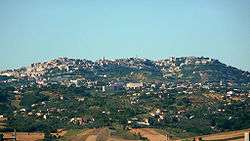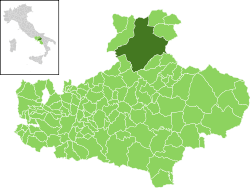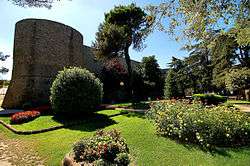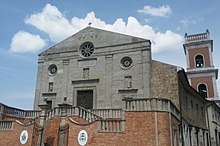Ariano Irpino
| Ariano Irpino | ||
|---|---|---|
| Comune | ||
| Città di Ariano Irpino | ||
 Panorama of Ariano Irpino | ||
| ||
 Ariano Irpino within the Province of Avellino | ||
 Ariano Irpino Location of Ariano Irpino in Italy | ||
| Coordinates: 41°9′0″N 15°5′3″E / 41.15000°N 15.08417°ECoordinates: 41°9′0″N 15°5′3″E / 41.15000°N 15.08417°E | ||
| Country | Italy | |
| Region | Campania | |
| Province | Avellino (AV) | |
| Government | ||
| • Mayor | Domenico Gambacorta | |
| Area | ||
| • Total | 186.74 km2 (72.10 sq mi) | |
| Elevation | 778 m (2,552 ft) | |
| Population (30 April 2017)[1] | ||
| • Total | 22,535 | |
| • Density | 120/km2 (310/sq mi) | |
| Demonym(s) | Arianesi | |
| Time zone | UTC+1 (CET) | |
| • Summer (DST) | UTC+2 (CEST) | |
| Postal code | 83031 | |
| Dialing code | 0825 | |
| Patron saint | Otto Frangipane | |
| Saint day | 23 March | |
| Website | Official website | |
Ariano Irpino (formerly Ariano di Puglia or simply Ariano) is an Italian town and municipality in the province of Avellino, in the Campania region. With a population of 22,535 (2017)[1] it is the second-largest town of the Irpinia district and of the province, with Avellino itself being the largest.
Geography

Overview
At an elevation of 778 metres (2,552 ft) above sea level, Ariano Irpino is centred between the Adriatic Sea and the Tyrrhenian Sea. It is 39 km east of Benevento, 51 km north-east of Avellino and 62 km south-west of Foggia.
Formerly called just Ariano, it was built on three hills, and for that reason it is also known as Città del Tricolle (City of the Three Knolls). From 1868 to 1930 it was known as Ariano di Puglia. Irpinia is the name given to the area of the Apennine Mountains around Avellino and Benevento; the name derives from the Oscan word hirpus, meaning wolf.
Ariano lies in the centre of a fertile but rugged district and has only a few buildings of importance, as it was devastated by earthquakes in 1456 and 1732. It was supposed to occupy the site of Aequum Tuticum, an ancient Samnite town which became a post-station on the Via Traiana and Via Herculea in Roman times, but this town is more likely to be found at S. Eleuterio, 8.2 kilometres (5.1 mi) north, whereas 20 kilometres (12 mi) south is the Sorgente Mefita, identical with the pools of Ampsanctus.[2]

Towering over the surrounding countryside, the town was a military position of some importance in the Middle Ages,[2] and it still has a Catholic diocese and retains many public offices and utilities which serve all surrounding smaller towns too. However, many inhabitants reside in farms and still live on agriculture or craftsmanship.
The climate is moderately rainy and mild, with rather little snow and rare hail.
Surroundings
The municipality borders Apice (BN), Castelfranco in Miscano (BN), Flumeri, Greci, Grottaminarda, Melito Irpino, Montecalvo Irpino, Monteleone di Puglia (FG), Savignano Irpino, Villanova del Battista and Zungoli.[3]
History
The city's origins are very ancient. Archeological evidence points to its continuous settlement from the Neolithic (c. 7th millennium BC) to around 900 BC at La Starza archaeoligical site. The foundation of the Italian, Greek, and Roman city of Aequum Tuticum was generally credited to the Homeric hero Diomedes, although others ascribed it to the Hirpini Samnites. Under the Romans, Aequum Tuticum was the crossroads of the Via Traiana and Via Herculeia highways. The town declined following the onset of the barbarian invasions.

As a result of this, the three hills started to be inhabited, a high and easily defendable place, and it is here that Ariano was born, a fortified city in a strategic position; today its ancient and formidable defensive walls are still recognizable and are part of the city. In a secure place away from the invasions of the Goths and Byzantines, Ariano is a fortified city of the Lombards. Around 800 the Castle was built to defend the city against the Byzantines which, although ruined, still proudly stands in the panoramic Villa Comunale city park.
Successively conquered by the Normans, in 1140 it was the place where Roger II of Sicily promulgated the Assizes of Ariano, the then-new constitution of the Kingdom of Sicily. This legal corpus would be adopted almost complete and with a few variations into the Constitutions of Melfi of the Emperor Frederick II. In the same year was coined the ducat, a coin that would last for seven centuries, until 1860.
In 1255, Manfred, son of Frederick II, besieged the city, which resisted strongly thanks to its walls and the combative nature of the inhabitants. During the siege, a group of soldiers from Lucera pretended to be deserters from Manfred's army, and were welcomed into the city. During the night, they revealed their identity, sacking and destroying the city with fire, and killing all the inhabitants. There is still a road marking the event, called La Carnale (The Carnage).
More than ten years later, in 1266, Charles I of Anjou rebuilt the city and gave it two thorns of the crown of Christ, still conserved in a reliquary into the city's Romanesque cathedral. All these events are commemorated every year in the Rievocazione Storica del Dono delle Sante Spine (Historical Reinvocation of the Gift of the Sacred Thorns) and in the reproduction of the Incendio del Campanile (Belltower Burning), a pyrotechnic event that lights the main square of the city and the side of the cathedral.
After the Capetian House of Anjou lost control of Sicily to Peter III of Aragon in the War of the Sicilian Vespers, the city passed to the Provençal family of Sabran from 1294 to 1413; and then into the hands of the Carafa family and the House of Gonzaga. Today are there still in the city buildings that belonged to the Spanish families that governed at the time. On 2 August 1545 the city rebelled against the feudal regime and became a Città Regia (city-state) dependent on the Viceroy of the Kingdom of Sicily.
Culture
Majolica
Ariano is known for the production of majolica, a tin-glazed pottery.[4] The first examples date from the 13th century under the Moorish influence of the Spanish, but Ariano Irpino's majolica became more refined around the 18th century, when the first amphoras and pitchers appear, often simple in the shape, but thinly elaborated. Today's production is bigger than ever, including flask, busts, cups, plates, figures, amphoras. All pieces are splendidly decorated by the craftsmen of Ariano, and often have a fine and elaborate shape.
Museums
Today the town houses some museums:
- the Civic Museum of Majolica;
- the Archaeological Museum, which displays artifacts from Aequum Tuticum;
- the Museum of Norman Civilization, in the Norman Castle;
- the Diocesan Museum of Silver, in the Cathedral, which displays two Sacred Thorns of the crown of Christ gifted to the town by King Charles I of Anjou in 1269;
- the Museum "Giuseppina Arcucci", at the Sisters of Holy Spirit's.[5]
Research activity
In the town are located C.E.S.N. (the European Centre of Norman Studies) and BioGeM (Biology and Molecular Genetics in the Mezzogiorno).
Food
Ariano`s countrypeople make much foodstuff from traditional agriculture. Many shops and restaurants offer produce as bread, pasta, pizza, cheese, meat, and olive oil.
In popular culture
The fictitious crime family depicted in the American television series The Sopranos trace their origins to this city. According to the narrative, the capostipites of the Soprano family (Corrado Soprano Sr. and Mariangela D'Agostino) emigrated from Ariano to New Jersey in 1911 (when the city was still called Ariano di Puglia); and some other characters also state that they are from Ariano. Specifically, Paulie Gualtieri states his grandfather was from Ariano Irpino in the episode Commendatori. The likely reason for this connection is that series creator David Chase traces his mother's family origins to Ariano.
People
_(14777069002).jpg)
- Ottone Frangipane (1040-1127), saint
- Saint Elzéar of Sabran (1285-1323), Count of Ariano
- Hieronymus Angerianus (1470-1535), humanist
- Diomede Carafa (1492-1560), bishop
- Pietro Paolo Parzanese (1809-1852), poet
- Luca Morelli (b. 1987), motorcycle racer
See also
References
- 1 2 (in Italian) Source: Istat 2011
- 1 2

- ↑ 41091 Ariano Irpino on OpenStreetMap
- ↑ (in Italian) The "Maiolica Arianese"
- ↑ Ariano Irpino on Visit Italy
External links
| Wikimedia Commons has media related to Ariano Irpino. |
| Wikivoyage has a travel guide for Ariano Irpino. |
- Official website (in Italian)
- Città di Ariano (in Italian)

